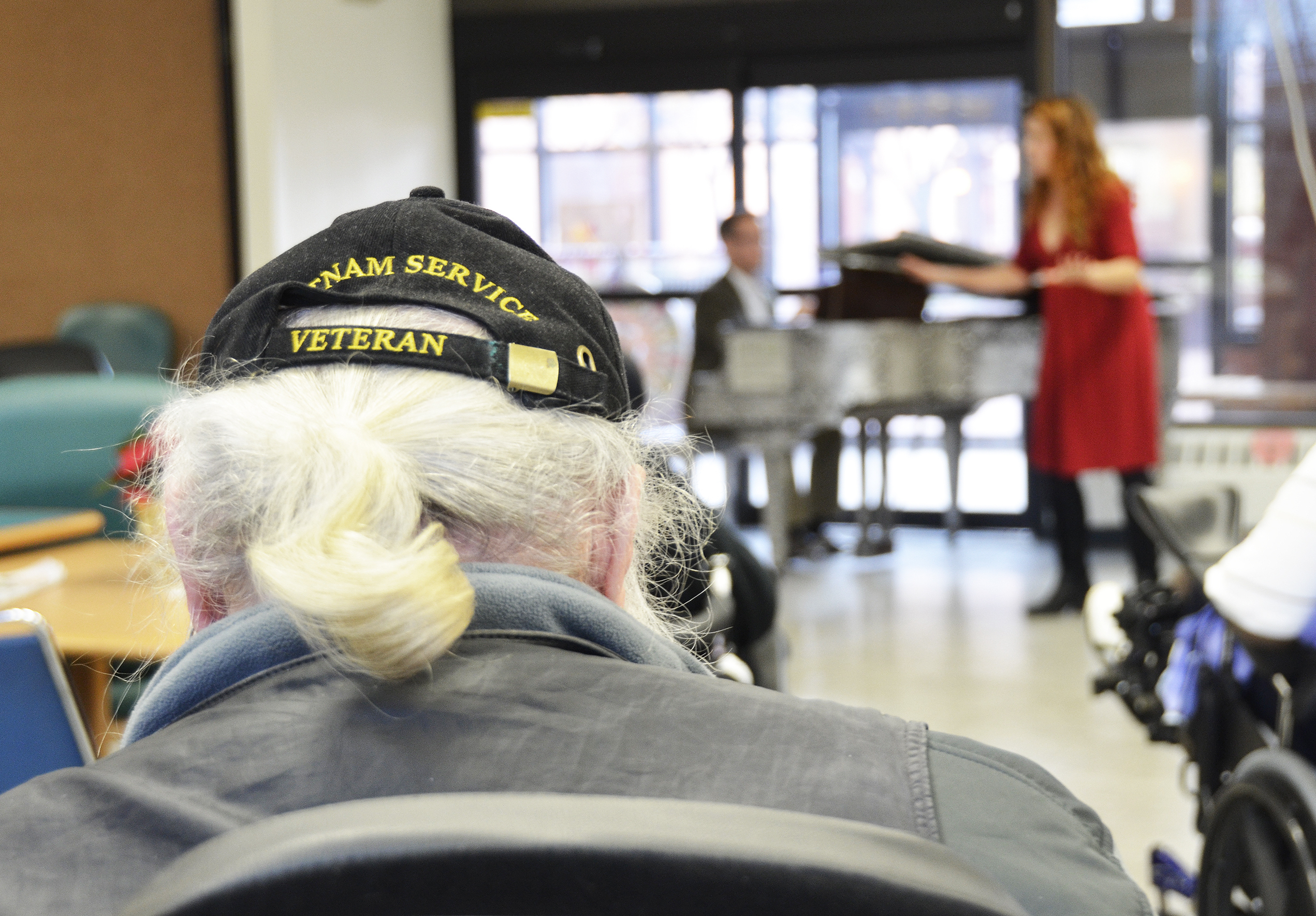The turn of a year—or a decade—makes evident that humans love to reminisce. Just take Instagram’s Top Nine, or Spotify’s Decade Wrapped. But people like veterans, trauma victims, and dementia patients know that not only is looking back sometimes difficult, sometimes it doesn’t even seem possible.
So how do we carve out more space for reclaiming memory and personal narrative safely and creatively? Increasingly, the healthcare world looks to art. The link between healing and creativity has led to a rich partnership between arts-based nonprofit Sing for Hope and James J. Peters VA Medical Center in the Bronx, NY. The partnership is comprehensive: VA staff members do an in-depth assessment of their residents’ needs and then work with Sing for Hope’s Healing Arts team to determine what arts interventions will best meet those needs. Sing for Hope then selects artists based on the fit of both the artistic style and personality match for optimal connection with the veterans.
Sing for Hope’s artistic lesson plans are as adaptive as the healing process is complex. For example, artist and workshop leader Sarah Doneghy knows that the concept of “self” is challenging for some clients at the VA, so her workshop calling for “self-portraits” from before veterans enlisted in the service did not require a face to appear. Doneghy recognizes that a self-portrait doesn’t always take the shape of a person, but rather captures the person’s essence and the treasured memories that art helps them reclaim. The veterans in Doneghy’s Early Risers Club—one of many Sing for Hope (SFH) programs at the James J. Peters VA Medical Center—respond more and more with each session.
“One veteran remembered a garden scene, so that’s what he drew from that time,” says Doneghy. “He was also determined to walk me through it, which helped him open up. He’s taken to giving me his pictures; only last week he would throw them away.”
This adaptive approach defines the multidisciplinary cultural partnership between Sing for Hope and the James J. Peters VA. For example, five artists presented Big Band Swing, an interactive concert specially curated to aid in long-term memory recall in a safe and supportive atmosphere. The cast’s preparation included both artistic rehearsal and training on how to engage their specific audience meaningfully and respectfully. Sing for Hope Artist Partners guided veterans through hit music from 1928 to 1948 in a program aided by contemporary dance, costumes, and period-appropriate slang. The specially trained cast framed each song in its historical context, from Prohibition to World War II. The design of “Big Band Swing” is grounded both in psychological research and in specific demographic data so that the music draws on a chronological progression of music from VA constituents’ youth. Sing for Hope’s custom playbill includes a section for “Reflections,” which SFH Artist Partners and VA staff use to guide veterans in recording their responses to the show.
Sing for Hope Artist Partners rehearse for “Big Band Swing” (program photos unavailable to respect the privacy of the veterans and staff)
When not presenting specialty concerts like Big Band Swing, Sing for Hope provides the veterans ample opportunity to participate actively in the creative process. On Mondays, veterans join professional visual artist Nick Stavrides for Art Cart, a mobile and collaborative visual art program that recently produced a mural for the VA. On Tuesdays, veterans join film/TV/theater actress Lexi Marceron for a dynamic Movement Workshop, building strength and coordination in a creative atmosphere.
That focus on adaptation and longevity allows the benefits of self-expression to continue even after Sing for Hope’s Artist Partners leave for the day. Veterans sometimes ask for projects they can do in their own free time. Monday workshops begin with a time for sharing work created since participants last met. The groups morph—while Doneghy reports that there is a core group of Early Risers, others take an interest and join when and however they are able. One veteran prefers to stop by to sit and watch. Another participates through poetry. In a medical facility, which can feel regimented, clinical, and lacking the freedom of choice, this flexibility is essential.
This work isn’t limited to VA Medical Centers: Sing for Hope applies a multidisciplinary arts-based approach to learning and healing at 25 other healthcare sites and over 200 schools.
The arts are often considered “nice to have”—a bonus, maybe even a value add, but not essential needs filled. But the needs met in Sing for Hope and James J. Peters’ adaptive arts programming are not peripheral. Memory recall, ensuring consistent stimulation for veterans with atypical waking hours, reclaiming a sense of agency, developing physical strength and coordination—these are all vital needs, directly tied to the health and healing of the veterans. One veteran recently presented an art tool to his trusted workshop leader and asked that they use it as he talked. Slowly, they put his story on paper. He kept returning to memories of a specific family member, and it became clear that he missed her deeply.
The conversation moved to childhood and early memories, and other veterans joined in. Though the workshop group evolves and appointments sometimes render them unavailable, at the end of that recent Friday session, all participants were adamant that they’d be there for the next session on Monday. VA staff reported a perceptible shift in some of the participants: an openness they hadn’t seen before, and a group of confidants formed and solidified.
As 2020 approaches, perhaps we can resolve to make space for those having trouble looking back or ahead, and vow to help ensure all people have allies to support them in their progress and vulnerability. The arts can help us in that pursuit… perhaps they already are (aren’t the visual Instagram Top Nine and musical Spotify Decade Wrapped themselves arts-based?).
To move without inhibition; to have the tools and freedom to see yourself reflected without judgment; to connect back to the person you were, are, or want to be: what could be more important than that?


